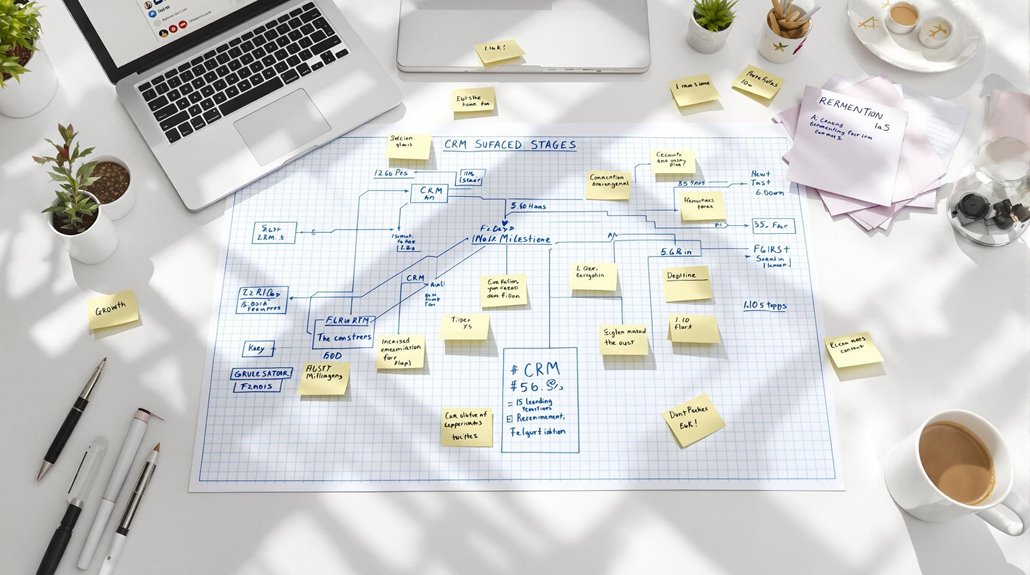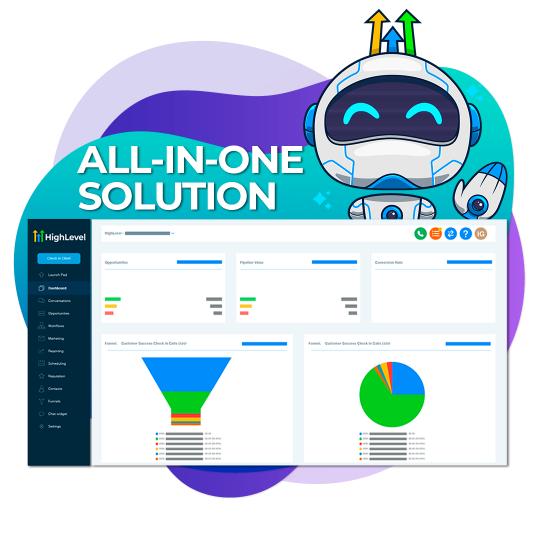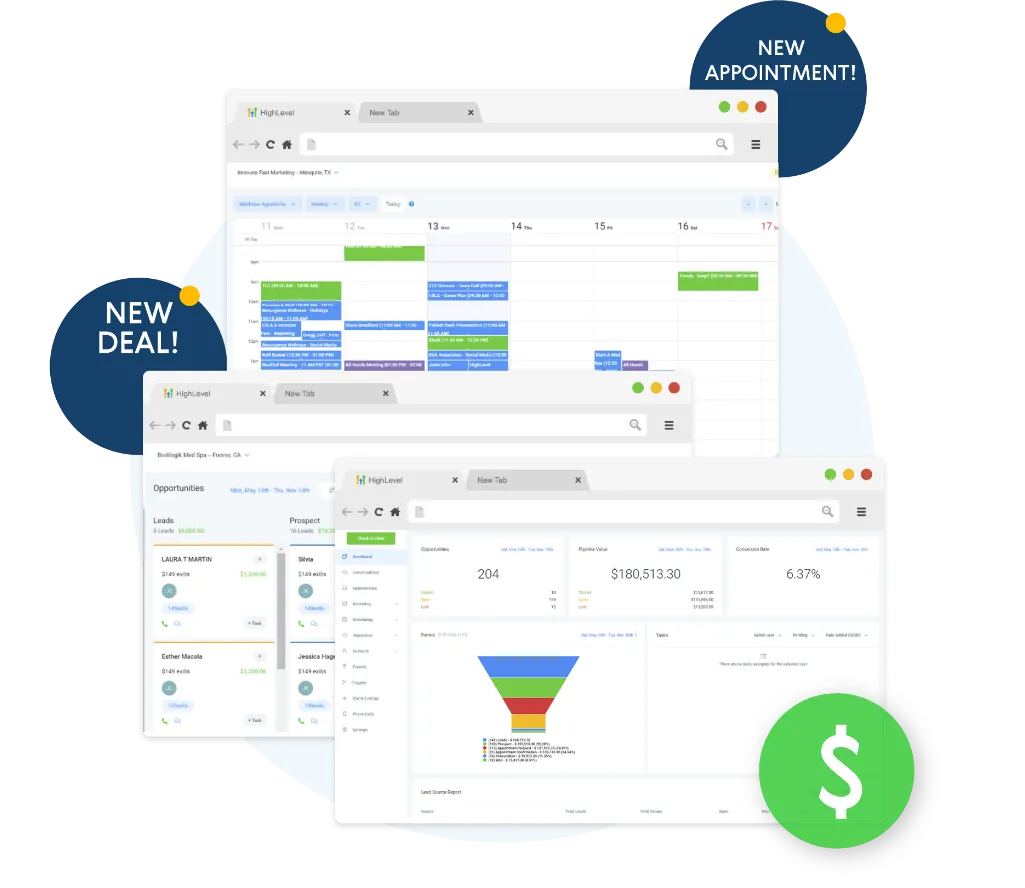Every growing business needs a simple way to keep track of customers. Think of a CRM system as your digital helper that keeps all your customer info in one place. It's like having a smart notebook that remembers every chat, call, and sale.
Most business owners say their CRM helps them make friends with customers. This is because they can see what each customer likes and needs. Your team will work better when they don't have to search for info in many places.
A CRM can do the boring jobs for you, like sending emails. This gives you more time to focus on growing your business. It also shows you what works and what doesn't with easy-to-read reports.
Start small with basic tools. Add more features as you grow. This way, your business can get bigger without getting messy.
Feeling overwhelmed by missed leads and disorganized workflows?
Discover the award-winning platform that automates follow-ups, tracks every lead, and keeps your business running smoothly—all in one place. Thousands of businesses are already transforming their sales and marketing with this trusted solution. Don’t miss out—start your 14-day free trial today and click now to uncover exclusive, limited-time special offers!
The Power of CRM

CRM helps businesses grow by making friends with customers. Think of it as a special tool that remembers what your customers like and need.
When you use CRM, you store all customer details in one place. This makes it easy to help them fast. Your team can work better because they don't waste time looking for customer info.
CRM shows you how well your sales are doing right now. It helps you spot what works and what needs fixing. Best of all, it helps you keep customers happy so they stick with you longer.
The more you know about your customers, the better you can help them. CRM gives you this power by turning customer chats into useful facts you can use to grow your business.
Understanding Your CRM Needs
Let's find out what your business needs for better customer care.
First, look at how your team works every day. Watch how they talk to customers and make sales. Write down what slows them down – like typing the same info over and over, or having customer details spread out in many places.
Maybe your team can't easily see how well sales are going. When you know these problems, you can pick the right tools to fix them.
Pick tools that help you now and can grow with your business later.
Identifying Core Business Requirements
Your business needs a simple CRM tool to help grow. Think about what you want it to do. It should help you keep track of customers and sales.
First, look at how your team works each day. You want the CRM to make their jobs easier. Pick tools that help you make more money, like:
- Ways to track sales
- Tools to reach new customers
- Help desk features
Make sure your team can use the CRM without getting stuck. The screen should be easy to read and use.
Also check that your data will stay safe and backed up. Your CRM should work well with other tools you use.
When you pick the right CRM, your team will work better and you'll see better results.
Assessing Growth Pain Points
Growing your company is tough. Many companies close within five years. To stay open, you need to find and fix problems early.
Your growing company may face these big problems:
- Customer info is all over the place
- Sales leads get lost or forgotten
- You can't see how happy your customers are
Pick tools that fix these problems now and can grow with you later. Start small with basic tools that:
- Save you time
- Keep all info in one place
- Show you what's working
When your team grows bigger, you can get better tools without causing trouble.
Ready to simplify your business operations?
Streamline your workflows and boost productivity with a CRM designed to save you time and effort. From tracking leads to automating follow-ups, this platform does it all. Discover what’s possible—learn more about how it works and see why so many businesses rely on it every day.
Building Your CRM Foundation

Let's start with the basics of a good CRM system.
First, pick a CRM that fits your needs. Think about what you want it to do. It should help you sell more and keep track of your work.
Next, split your customers into groups. This helps you talk to them better. Set up your CRM to do tasks on its own. This saves you time.
Keep an eye on who might buy from you. Your CRM can show you how close each sale is to closing. This makes it easy to know what to do next.
Look at what the numbers tell you. Your CRM shows how customers act and what they like. Share this info with your team.
Make sure everyone uses the CRM – the sales team, the marketing team, and the people who help customers.
When everyone works together, you can grow your business better.
Still struggling to keep your business organized?
Take the guesswork out of managing leads and follow-ups with a platform trusted by thousands of businesses. Say goodbye to missed opportunities and hello to a seamless sales process. Act now—try it free for 14 days and discover how easy it is to stay on top of your workflow. Don’t wait—exclusive offers won’t last long!
Choosing Your Tech Stack
Picking the right tools helps your new business grow better.
Think of your CRM tool like building blocks – you want ones that fit with what you have now and what you'll need later. The tools you pick today will help your team work well tomorrow.
When looking at tools, check these three big things:
- Make sure your tools can talk to each other. Like Lego blocks, they need to fit and work together.
- Pick tools that can grow with you. Like adding rooms to a house, you want to add new parts when needed.
- Your tools need to work well with lots of info. Like a bucket that won't spill when it gets full.
Creating Implementation Milestones

Let's make your CRM system work step by step. Each month needs clear goals to show what we'll do. We start small with simple things like moving data and teaching people. Think of it like building blocks:
- Plan what we want
- Set up the system
- Test if it works
- Start using it
Keep track of what works and what needs to change. Make sure people use the system and that all parts work together.
You can always fix things if they don't go as planned. The key is to take small steps and celebrate when things go well.
Setting Month-by-Month Goals
Setting Goals Month by Month
Getting your CRM up and running takes time. Let's break it down into simple steps you can do each month. This helps you stay on track and build on what you learn.
Month 1:
- Set up your basic system
- Plan how to move your data
- Choose who does what
- Pick ways to track success
Month 2:
- Show people how to use it
- Set up simple ways to work
- Put all contacts in one place
- Watch how well people use it
Month 3:
- Turn on cool new features
- Connect it to other tools
- Make it work better based on what users say
- Fix problems you find
Give yourself extra time for things that might go wrong.
Keep checking if you're meeting your goals. This will help make sure your CRM works well for your team.
Track Progress Through Phases
Let's break down how to track your CRM project step by step. We want to make sure you hit your goals at each stage.
Think of your project like building blocks. Each block needs to fit just right before you add the next one.
Here are the main stages:
Planning Stage
- Write down what data you need
- Pick who does what on your team
Building Stage
- Set up your system just how you want it
- Test if everything works together
Launch Stage
- Show everyone how to use it
- Get the whole system up and running
Take your time with each stage. Moving data and training people are very important steps. Don't rush them. Leave extra time for fixing any problems that pop up.
Keep checking if you're meeting your goals. This helps make sure your CRM will grow with your business.
| Stage | What to Check |
|---|---|
| Planning | Data Plans Done, Team Jobs Set |
| Building | System Setup Done, Testing Started |
| Launch | Training Done, System Running |
Struggling to keep up with your growing business?
Simplify your processes and stay ahead with a CRM that adapts to your needs. Manage leads, automate tasks, and focus on what matters most—growing your business. Take the first step—explore the features today and see how it can transform the way you work.
Training Your Sales Team
Getting your sales team to use your new CRM tools the right way helps your business grow. Think of it like teaching a friend to ride a bike – they need to learn step by step.
First, show your team how to use the basic tools. Make sure they know how to put customer info in the right way.
Next, have short practice times every month. This helps your team remember the right ways to use the tools and fix any bad habits.
When you get new updates or see your team having trouble, give them quick lessons to help them do better.
Keep the training fun and short. Use real numbers to show how the tools help sell more.
When you train your team well, they can help more customers and make more sales.
Measuring CRM Success

When your team learns to use the CRM tool well, you need to check if it's helping. Look at simple things like how many sales you make and how much money comes in. See if your customers stay with you over time.
Watch how long each sale takes to find where deals get stuck. Look at what you spent on the tool and what you got back from it. The numbers will tell you if it works.
Keep track of who sells the most. Look at why some deals don't work out. Ask your team what they think about the tool – if they like it, they'll use it better.
Use what you learn to make your CRM work better for everyone.
Adapting to Growth Challenges
As your business grows bigger, you need better ways to manage your customer info.
Think of it.
Future-Proofing Your CRM Strategy

We need to make our customer tools ready for the future.
Markets keep changing. So we must make smart plans for how we talk to our customers. Think of it like building with blocks – we want to add or change things easily.
First, make a clear plan that fits what you want your business to be. Pick tools that work online and can grow with you. Use smart computer helpers to spot what customers might want next. Let the computer do the boring work too.
Listen to what works and what doesn't. Look at what other businesses do well. This helps you stay strong as things change.
Make sure your tools can connect with new ones that come along.
Remember: Our tools need to work both today and tomorrow. Keep them simple and ready to grow.
Conclusion
Think of building your CRM system like making a house. Just as you need good plans to build a home, your startup needs a clear CRM plan to grow bigger. Your CRM is more than just a tool – it's how you make friends with customers and keep them happy. When you set it up right from the start, you can help more people and make more money. Take small steps each day to make your CRM work better. This will help your business win against others who don't plan ahead.








